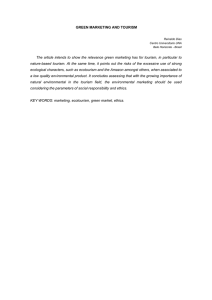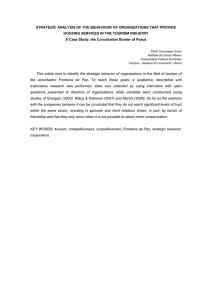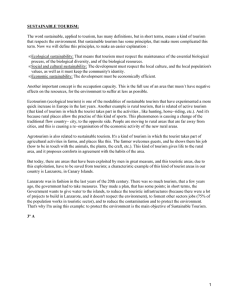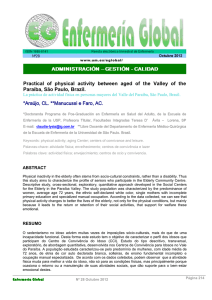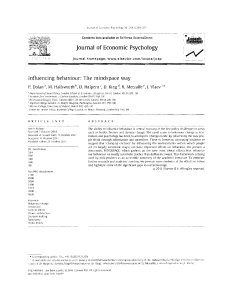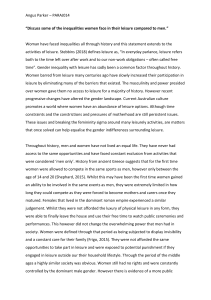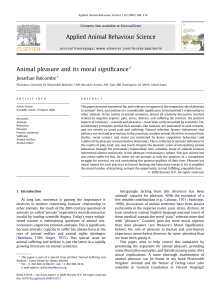age of seniors – a challenge for tourism and leisure industry
Anuncio
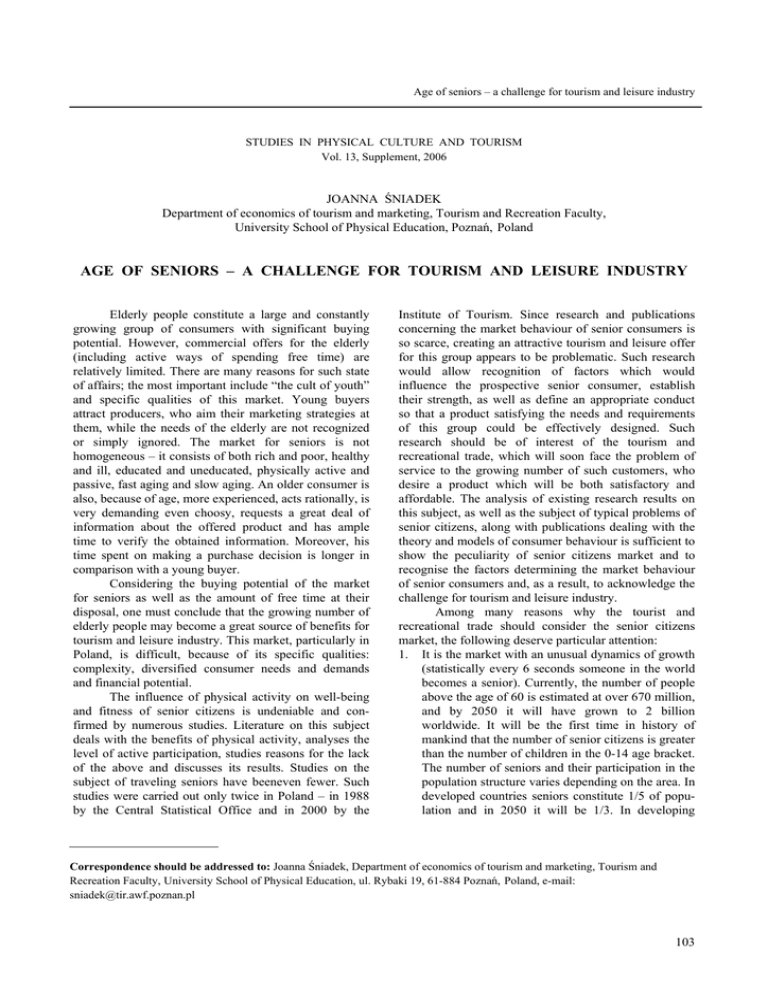
Age of seniors – a challenge for tourism and leisure industry STUDIES IN PHYSICAL CULTURE AND TOURISM Vol. 13, Supplement, 2006 JOANNA ŚNIADEK Department of economics of tourism and marketing, Tourism and Recreation Faculty, University School of Physical Education, Poznań, Poland AGE OF SENIORS – A CHALLENGE FOR TOURISM AND LEISURE INDUSTRY Elderly people constitute a large and constantly growing group of consumers with significant buying potential. However, commercial offers for the elderly (including active ways of spending free time) are relatively limited. There are many reasons for such state of affairs; the most important include “the cult of youth” and specific qualities of this market. Young buyers attract producers, who aim their marketing strategies at them, while the needs of the elderly are not recognized or simply ignored. The market for seniors is not homogeneous – it consists of both rich and poor, healthy and ill, educated and uneducated, physically active and passive, fast aging and slow aging. An older consumer is also, because of age, more experienced, acts rationally, is very demanding even choosy, requests a great deal of information about the offered product and has ample time to verify the obtained information. Moreover, his time spent on making a purchase decision is longer in comparison with a young buyer. Considering the buying potential of the market for seniors as well as the amount of free time at their disposal, one must conclude that the growing number of elderly people may become a great source of benefits for tourism and leisure industry. This market, particularly in Poland, is difficult, because of its specific qualities: complexity, diversified consumer needs and demands and financial potential. The influence of physical activity on well-being and fitness of senior citizens is undeniable and confirmed by numerous studies. Literature on this subject deals with the benefits of physical activity, analyses the level of active participation, studies reasons for the lack of the above and discusses its results. Studies on the subject of traveling seniors have beeneven fewer. Such studies were carried out only twice in Poland – in 1988 by the Central Statistical Office and in 2000 by the Institute of Tourism. Since research and publications concerning the market behaviour of senior consumers is so scarce, creating an attractive tourism and leisure offer for this group appears to be problematic. Such research would allow recognition of factors which would influence the prospective senior consumer, establish their strength, as well as define an appropriate conduct so that a product satisfying the needs and requirements of this group could be effectively designed. Such research should be of interest of the tourism and recreational trade, which will soon face the problem of service to the growing number of such customers, who desire a product which will be both satisfactory and affordable. The analysis of existing research results on this subject, as well as the subject of typical problems of senior citizens, along with publications dealing with the theory and models of consumer behaviour is sufficient to show the peculiarity of senior citizens market and to recognise the factors determining the market behaviour of senior consumers and, as a result, to acknowledge the challenge for tourism and leisure industry. Among many reasons why the tourist and recreational trade should consider the senior citizens market, the following deserve particular attention: 1. It is the market with an unusual dynamics of growth (statistically every 6 seconds someone in the world becomes a senior). Currently, the number of people above the age of 60 is estimated at over 670 million, and by 2050 it will have grown to 2 billion worldwide. It will be the first time in history of mankind that the number of senior citizens is greater than the number of children in the 0-14 age bracket. The number of seniors and their participation in the population structure varies depending on the area. In developed countries seniors constitute 1/5 of population and in 2050 it will be 1/3. In developing Correspondence should be addressed to: Joanna Śniadek, Department of economics of tourism and marketing, Tourism and Recreation Faculty, University School of Physical Education, ul. Rybaki 19, 61-884 Poznań, Poland, e-mail: [email protected] 103 Joanna Śniadek countries the number of elderly people is smaller, today they make only for 8% of population, but by 2050 it will have reached 20% [5]. 2. It is the market with the greatest budget of free time. Studies show that senior citizens devote 40% more time than younger people to tourism and recreation. 3. It is a relatively affluent market. The buying potential of French seniors is estimated at €150 billion per year. The U.S. seniors have at their disposal the buying fund of $2 billion and they spend annually over $30 billion on trips. In general, senior citizens account for 70% of all passengers of cruise ships and 80% of luxurious trips customers. They also spend 74% more on “typical” holidays than people between 18 and 49 years of age. Polish seniors, although far less wealthy, have also relatively large buying potential, currently estimated at 90 billion zlotys. By 2050 it will have increased four times. 4. Senior citizens enjoy good health and physical condition longer and longer and, what is most important, they want to maintain this state of affairs. The tourist and recreational activity can particularly serve this purpose. 5. Seniors, especially from the baby-boomers category, start to replace their devotion to family with selfeducation, fun and entertainment, and they treat tourism and recreation as the prize they deserve for their busy lives full of sacrifices. 6. Seniors are not the favorable targets during the tourist season as they willingly leave for trips outside the season. 7. Social reasons (e.g. improvement of health, which will result in lower expenditure for health treatment) should be also emphasised. This aspect, however, is only taken into account by public institutions and non-profit organizations. The condition one must fulfill to be successful on the “grey hair” market is to define it precisely (Who is the present-day senior-buyer of goods and tourist services?) as well as to thoroughly identify its needs, expectations and requirements, shaped by various factors and situations (What is the buying behaviour of a modern senior?) Defining the notion “senior” and marking the boundary between the mature and elderly persons, several aspects should be considered: economic (retirement), cultural (customs, traditions), social (becoming a grandparent) and medicinal (loss of health or physical fitness). Marketing and economic studies assert that the senior citizen category starts at the age of 60, but it, in turn, can fall into several subcategories (Fig. 1) [4]. 104 60 55 64 pre-retiree and early retiree SENIOR 65 – 74 75 – 84 old retiree or mature adult retiree 85 and above elderly Figure 1. Senior categories. Source: own research based on: M.C. Walker, Marketing to seniors, 1st Books Library, Bloomington 2004 In order to conduct effective marketing actions on the senior citizens market it is necessary to recognise factors which can influence the buying behaviour of its members as well as single out a definite senior consumer profile based on these factors (Fig. 2). age and sex finances health education social role values and beliefs information Consumer behaviour Decision process needs social status culture motivations Enterprises, institutions and their marketing activity (offers, prices, advertising, etc) emotions family and other reference groups generation stage of the life cycle other factors media Figure 2. Factors influencing senior consumer behaviour. Source: own research Among the many factors affecting the decision-making process and purchasing behaviour of senior consumers, the ones that are especially noteworthy are those which are particularly influential. These are: the current stage of life (family life cycle) and current events, their nature and course, belonging to a particular generation (cohort) and cherished values [1, 3]. Taking into account the family life cycle, it is thought that the events particularly influential in the life of senior citizens, and in turn having an impact on their market behaviour, are: children moving out, retirement, birth of grandchildren and death of a spouse (Fig. 3). Belonging to a particular generation and cherished values have been so far the least recognized determinants of the senior market behaviour, though at the same time probably most important. These are factors which will determine their priorities: family life, providing for the family and themselves, simple pleasures, physical fitness and prolongation of youth or anxieties connected with their future lives. Their system of values is relatively constant and is formed in Age of seniors – a challenge for tourism and leisure industry childhood and early youth, often under the influence of current political (war, peace, political system), economic (times of crisis and prosperity), social (conflicts, civil movement) or cultural (subcultures, music, films) events witnessed by a particular person and his or her peers. Demographers call these groups “cohorts”. 1 every 6 seconds single/ couple family couple 55-60 28 birth of first child last child leaving home 1 death of parents 2 3 single 75 REFERENCES [1] Kotler Ph., Marketing, Rebis, Poznań 2005, pp. 177, 184. [2] Meredith G., Schewe Ch., The Power of Cohorts. American Demographic, (in:) Ph. Kotler, ed., Marketing management, Prentice Hall 2000, p. 266. [3] Serriere F., Les Séniors et Baby-boomers. Segmentations. Age cognitive., Réseau Senior Strategic, Grenoble 2002. [4] Walker M.C., Marketing to seniors. 1st Books Library, Bloomington 2004, p. 9. [5] World Population Prospect: The 2004 Revision Population Database, UN, http://esa.un.org begining of widowhood 4 retirement birth of first grandchild Figure 3. Life cycle stages. Source: own research based on: Les Séniors et Baby-boomers. Segmentations. Age Cognitif, Réseau Senior Strategic, Grenoble 2002 Marketing specialists aiming at drawing attention of the specific generation (e.g. seniors or baby-boomers) must reach for the icons and memorable images derived form the experiences of that cohort [2]. Belonging to a given cohort along with cherished values, stage of life and other factors determining market behaviour allow isolation of definite senior consumer profiles, which are essential for optimal design of marketing tools. Summing up, for the tourism and leisure industry, the consequences of ageing society and the resulting challenges connected with the senior consumer service include: – Increasing demand for tourism service and travelling for the purposes of health prophylaxis, rehabilitation and prolongation of youth (spas, wellness facilities, plastic surgeries and rehabilitation abroad) – Increasing demand for out-of-season holidays – Increasing demand for quiet places with a mild climate – Necessity of offer adaptation to the buying potential (financial and health aspects in particular) – Necessity of providing with highest possible quality, comfort and safety – Necessity of using comfortable and fast as well as cheap means of transport – Necessity of creating offers for people travelling alone – Awareness of the fact that marketing materials should put comfort first over the age. 105
